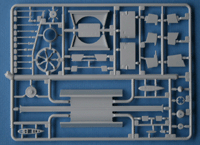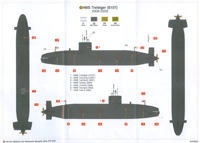Royal Navy Trafalgar Class Submarine

Reviewed by Tracy White

| HISTORY & CHARACTERISTICS | ||||||||
|
The Royal Navy's Trafalgar class submarines were an upgrade to the earlier Swiftsure class of submarine, with construction beginning in 1978 and seven entering service by October of 1991. They have seen action in the war on terror as well as deployments to Australia and the North Pole. The Trafalgar herself was retired in December of 2009, but other ships in the class are planned to operate until 2022. This class features a nuclear power plant, five torpedo tubes, and one of the best sonars arrays of the world navies. Trafalgar served with a conventional propellor, but the rest of the submarines were built with ducted propulsors, offering lower noise less chance of detection. While most have been painted the standard black, one has sported an experimental dazzle scheme (Trenchant) and another a dark blue color above the waterline (Torbay), allowing for some variation and variety for those with a large submarine collection.
|
||||||||
| Sprue A: Hull Parts | ||||||||
|
The hull is broken down in three pieces; an upper single piece and two lower ones; this is done to allow for an accurate representation of the class' sonar dome and for crisp detail on the torpedo doors on the side. It is not broken down along waterline, so those who wish to do a representation in the water will still have some cutting or sanding work ahead of them. There was a very slight machining pattern on upper piece from the sail forward about a quarter inch up from the edge in thickness on mine, but it should sand away very easily or perhaps not even show after a coat of primer and paint. Fit of the pieces is fairly good; working them together a couple of inches at the time produced seams that needed just a thin bead of filler in spots. There was no appreciable warpage or distortion to make note of. The lip arrangement is appreciated; on many of the subs that I have built with just flat joints in this area I have split the hulls repeatedly while sanding due to lack of strength and this has not been the case in any of the work thus far. There is some detail missing and the detail itself is a bit heavy, although nothing that will look out of place with paint and weathering or even a pristine model. There are two vents outboard of the sail that are over-sized and too far aft; this may cause issue for those wanting to do HMS Trenchant's 1999 dazzle scheme or HMS Torbay's steely blue topside scheme, but otherwise should not affect anyone other than the accuracy police. Rivet counters will wish to consult references for the specific boat they are representing as there are little differences between each the class, such as some oblique openings on the port side (HMS Talent shows five in one photo whereas HMS Triumph only two) |
||||||||
 |
||||||||
|
||||||||
| Sprue B: Sail & Detail Parts | ||||||||
|
One tree of parts is all that's needed for the rest of the model. Options for a "clean" or "deployed" sail are provided, although once again rivet counters may wish to research the configuration as a photo of the top of HMS Torbay's sail seems to indicate that a couple of the openings that are represented as flush in the "clean" sail are merely openings that lack a door. Parts are also included for either Trafalgar's conventional submarine propellor or the rest of the class' pump jet.
|
||||||||

|
||||||||
|
||||||||
| DECALS | ||||||||
|
A 2" x 5.5" sheet of decals is provided, with generic markings applicable to all boats of the class as well as specific placards for both the sail and the stand. Colors are in register and there is a minimum of excess film around the individual pieces. |  |
|||||||
| INSTRUCTIONS | ||||||||
|
Seven pages of instructions are provided. Diagrams are clear and uncluttered and provide a logical assembly sequence. The only gripe I have with them is that the sheet defining the different options (propulsor versus propeller, for example) is at the very back of the instructions sheet instead of the front. Once one realizes it is there, however, there are no problems tracking which parts to use for the chosen version. Included separately is a single-sheet four-view color diagram & decal placement chart. Colors are given in Humbrol numbers and names. Unfortunately no mention is made of an experimental dazzle scheme HMS Trenchant carried in 1999 nor HMS Torbay's current "Steely Blue" (I haven't found an official name for this color yet but this seems to be what web sites have settled on) color. Otherwise this color chart will serve nicely with all of the details and decal placements the builder will need. |
 |
|||||||
|
||||||||
| CONCLUSIONS | ||||||||
|
Fans of either modern submarines or the Royal Navy's submarine service have something to be very happy about. This is a good kit at a great price. There are enough of the class with an interesting history or paint scheme that multiples are a possibility without breaking the bank. Thanks to Skyway Model Shop for the review kit.
|
||||||||
